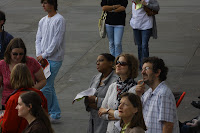 It is an art project and the participants are known as the plinthers. So, is Holy Communion art and did Ken’s appearance on the Plinth answer the question? Ken told me he hadn’t:
It is an art project and the participants are known as the plinthers. So, is Holy Communion art and did Ken’s appearance on the Plinth answer the question? Ken told me he hadn’t: “No, and I don’t think that can ever be answered,” he said. “I don’t think we ever wanted to show Holy Communion as art. Antony Gormley said that one of his aims was to explore the connection between people and, for me, worship is a connection. So, that is what we were using – the opportunity to connect with each other, with the wider community through our prayers and with God. Is Communion art? No. Is it right to do it in this way? I don’t know, but I feel deeply that it should be.”
Here is Ken on the plinth:

The great thing about the Methodist tradition is that you don’t have to be christened, baptised or confirmed to receive Communion, as you do in some other Christian denominations. This means people like me can receive it with no questions asked and no more commitment made other than commitment to the moment of sharing Communion. You don’t have to give your name or be declared “special”; everyone is equal in receiving Communion.
Here is glimpse of the crowd of onlookers:
Here they are again, lost in reflection:

Check out One and Other website here: http://www.oneandother.co.uk/


2 comments:
Ah, the ritual/ art thing. I might be wrong about this, but as I understand it, Rudolf Steiner thought that an act of ritual is a form of performance art.
I can see that, but like to think that while there is a convergence, they remain in two separate domains. Perhaps it depends on what your stakes are when participating in a ritual or a piece of performance art. If you're doing it to feel connected with an ancient tradition, they are separate things.
Can't decide.
That is the back of my head in one picture (red jacket). It was a wonderful experience, and I was glad to be taking part. Art? I don't know.
Post a Comment